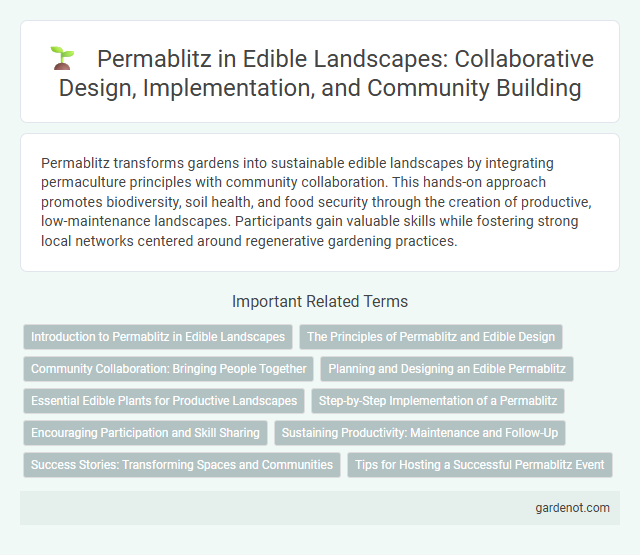Permablitz transforms gardens into sustainable edible landscapes by integrating permaculture principles with community collaboration. This hands-on approach promotes biodiversity, soil health, and food security through the creation of productive, low-maintenance landscapes. Participants gain valuable skills while fostering strong local networks centered around regenerative gardening practices.
Introduction to Permablitz in Edible Landscapes
Permablitz is a community-driven event that brings together people to collaboratively design and create edible landscapes using permaculture principles. Emphasizing sustainability, biodiversity, and local food production, permablitz projects transform urban and suburban spaces into productive ecosystems. These gatherings foster knowledge exchange, hands-on skill development, and strengthen community bonds while increasing access to fresh, organic food.
The Principles of Permablitz and Edible Design
Permablitz embraces principles such as community collaboration, sustainable resource use, and regenerative practices to create productive, edible landscapes. The design emphasizes integrating diverse plant species that provide food, enhance biodiversity, and improve soil health. Edible design in Permablitz maximizes space efficiency through permaculture techniques, ensuring resilient and self-sustaining gardens that support local ecosystems.
Community Collaboration: Bringing People Together
Permablitz events foster community collaboration by uniting neighbors, gardeners, and permaculture enthusiasts to co-create sustainable edible landscapes. These gatherings enable skill-sharing, hands-on learning, and collective labor, transforming private and shared spaces into productive food gardens. By strengthening social bonds and promoting environmental stewardship, Permablitz cultivates resilient local food systems and empowered communities.
Planning and Designing an Edible Permablitz
Permablitz events emphasize collaborative planning and designing an edible landscape that maximizes food production while enhancing biodiversity. Key elements include site assessment, selecting diverse perennial and annual food plants, and integrating water-efficient irrigation systems. Thoughtful layout ensures accessibility, soil health through composting, and ecosystem support by incorporating native species.
Essential Edible Plants for Productive Landscapes
Permablitz events foster community-based permaculture design with essential edible plants like perennial herbs, fruit trees, and nitrogen-fixing legumes to create highly productive landscapes. Integrating dynamic accumulators such as comfrey and productive berry bushes enhances soil fertility and supports diverse yields. These strategically selected plants optimize food production while promoting ecological balance in sustainable edible landscapes.
Step-by-Step Implementation of a Permablitz
Permablitz involves a community-driven, hands-on approach to creating sustainable edible landscapes by combining permaculture principles with collective labor. The step-by-step implementation typically begins with site assessment and design planning, followed by organizing volunteer participants, sourcing materials, and preparing the ground for planting. Key activities include soil improvement, planting diverse edible species, installing water-efficient systems, and applying mulch to enhance soil health and productivity.
Encouraging Participation and Skill Sharing
Permablitz fosters community engagement by organizing hands-on edible landscape workshops where participants collaboratively design and plant sustainable gardens. Skill sharing is emphasized through peer-to-peer learning, enabling individuals to gain practical knowledge in permaculture techniques and soil health management. This collective approach boosts local food resilience while empowering neighbors to create productive green spaces.
Sustaining Productivity: Maintenance and Follow-Up
Permablitz integrates community-driven strategies to sustain productivity through regular maintenance and collaborative follow-up activities, ensuring the longevity of edible landscapes. Implementing techniques such as soil regeneration, pest management, and seasonal crop rotation supports continuous yield and ecosystem health. Continued education and shared responsibility among participants reinforce the resilience and productivity of the permaculture system.
Success Stories: Transforming Spaces and Communities
Permablitz projects have successfully transformed urban and suburban spaces into thriving edible landscapes, fostering community resilience and biodiversity. These collaborative efforts have turned underutilized areas into productive gardens, providing fresh food and educational opportunities for diverse participants. The resulting green spaces enhance local ecosystems while building social cohesion and food security within neighborhoods.
Tips for Hosting a Successful Permablitz Event
Hosting a successful Permablitz event requires clear communication with participants about goals and tasks to ensure efficient collaboration in creating edible landscapes. Organizers should prepare the site in advance by marking planting areas, gathering necessary tools, and sourcing seeds or plants suited to the local climate. Providing hands-on guidance and fostering a community spirit encourages knowledge sharing and sustainable gardening practices among attendees.
Permablitz Infographic

 gardenot.com
gardenot.com